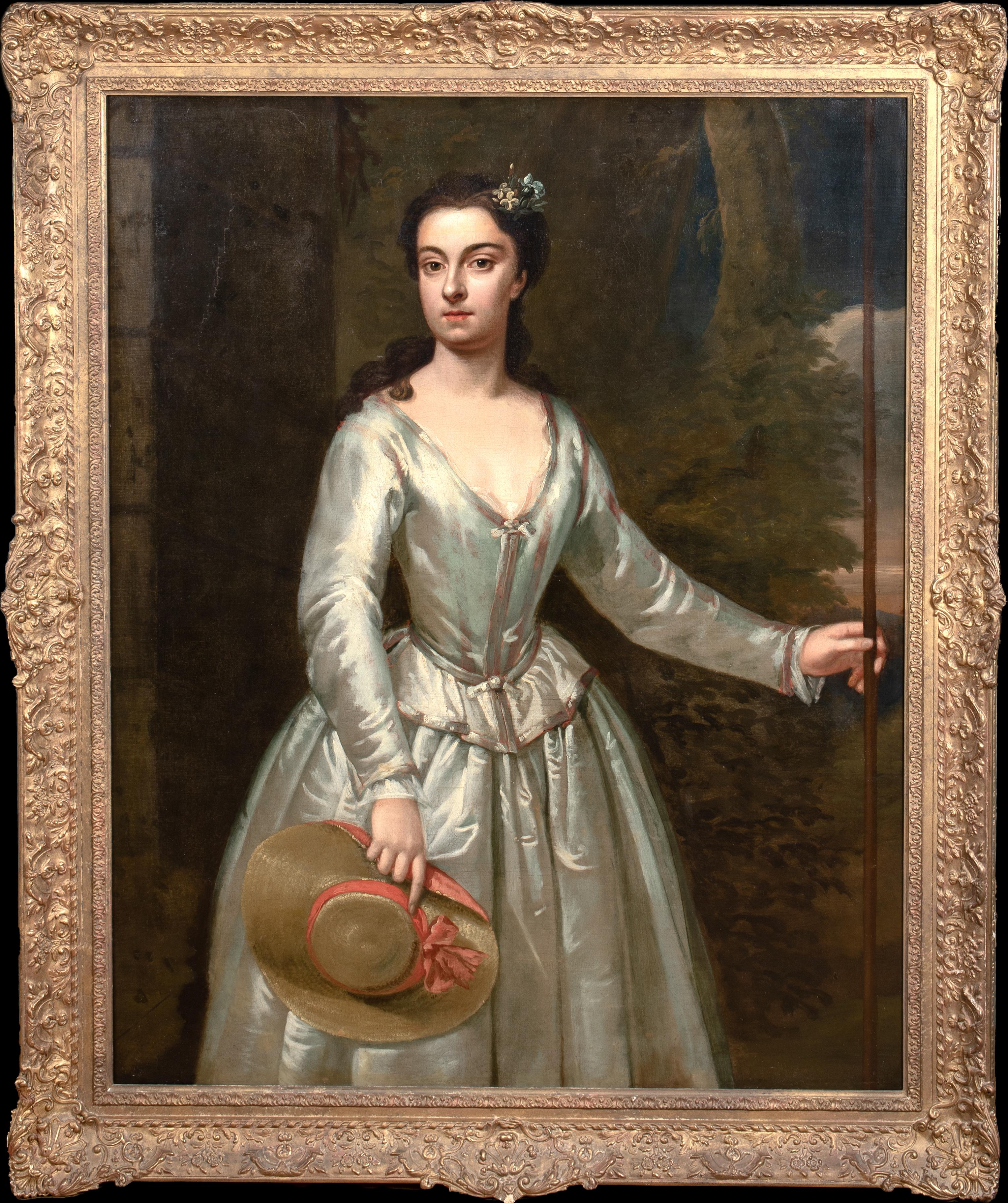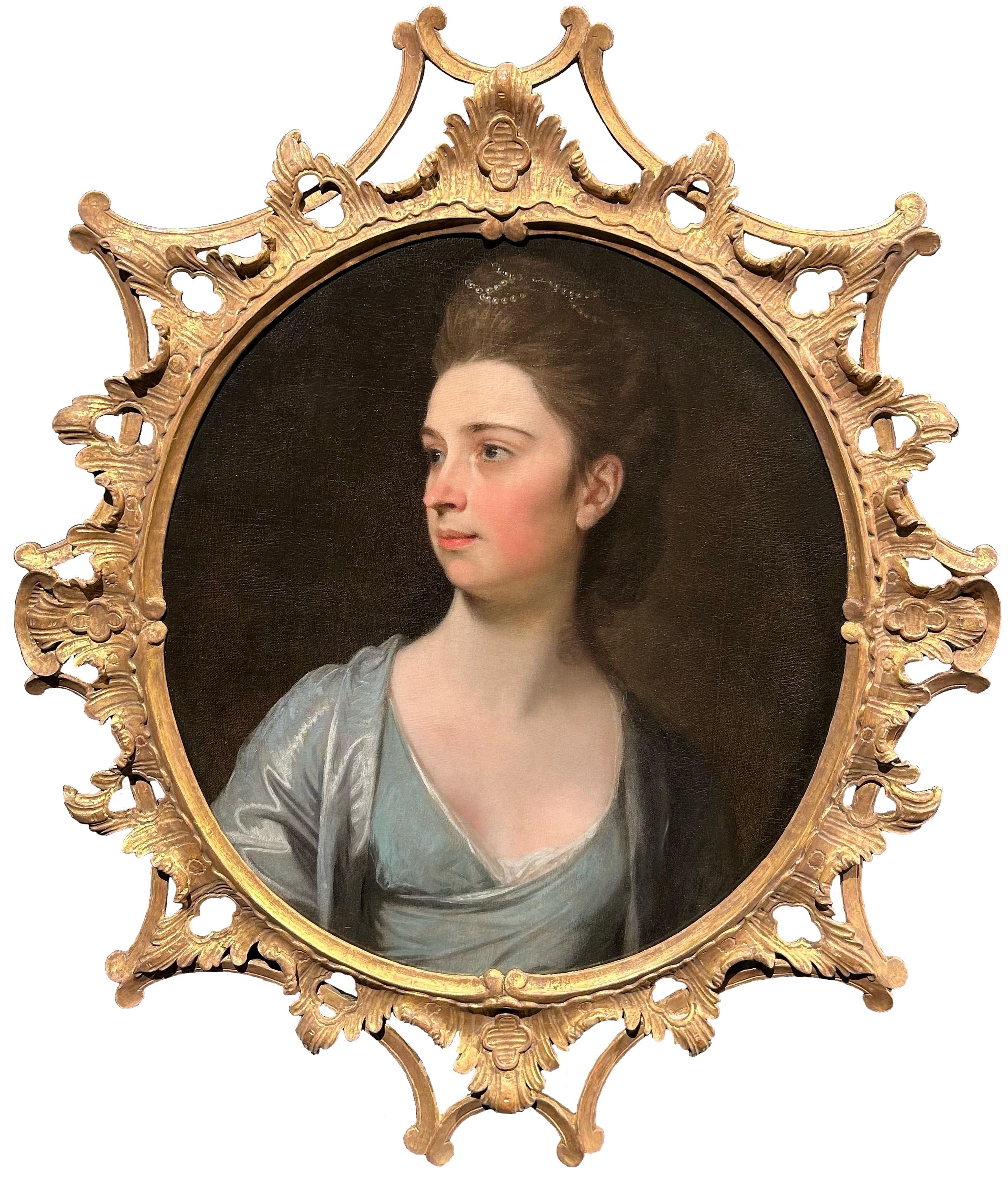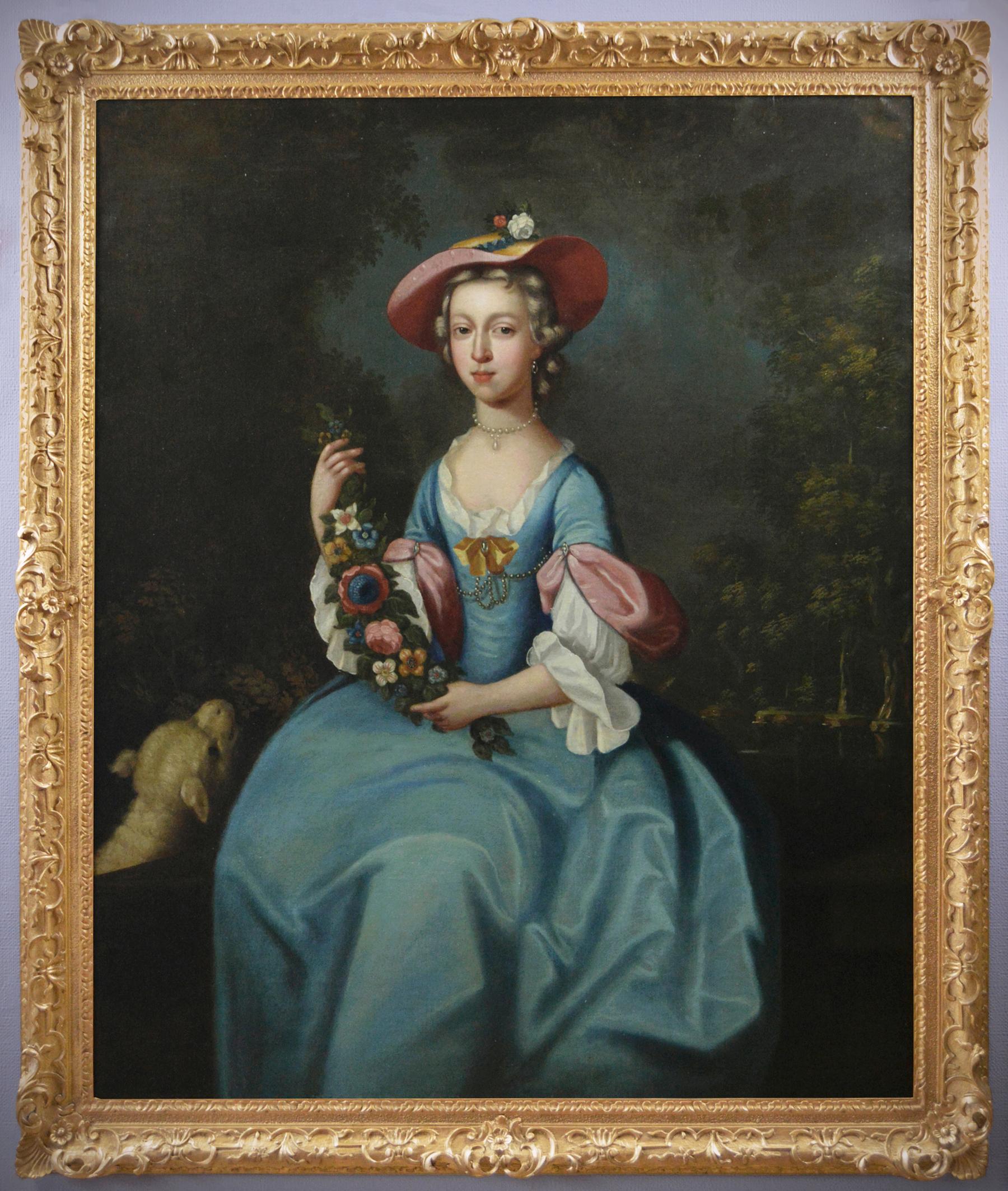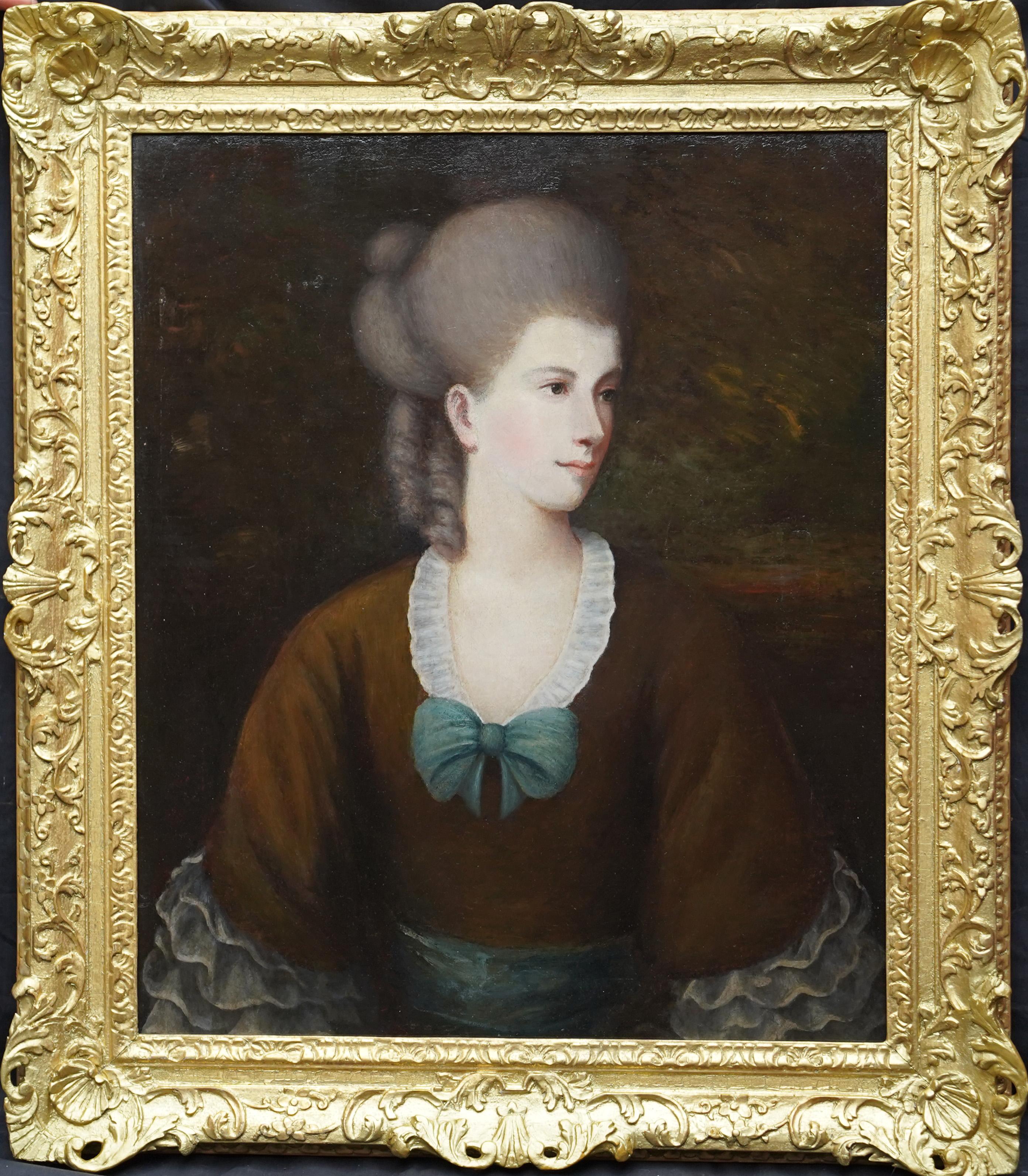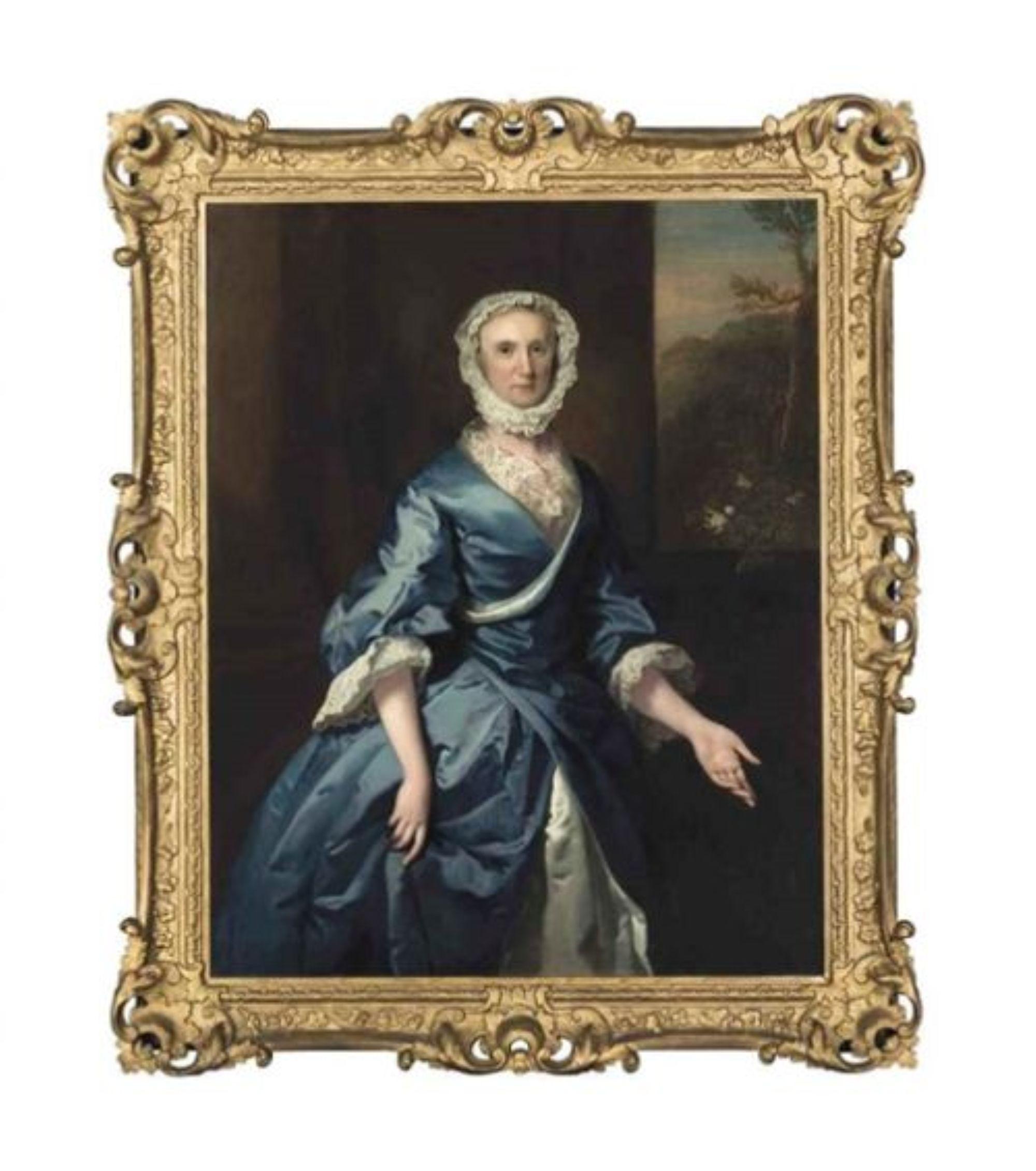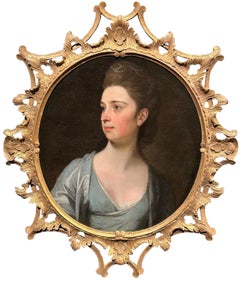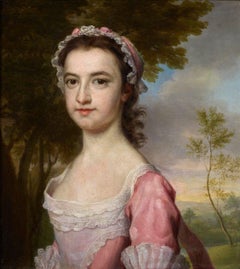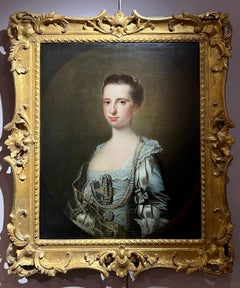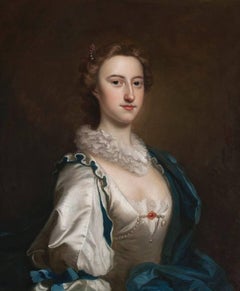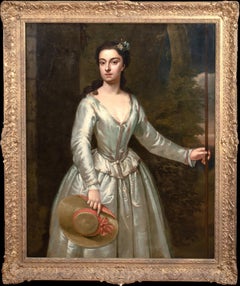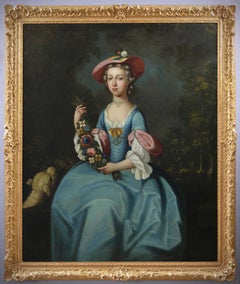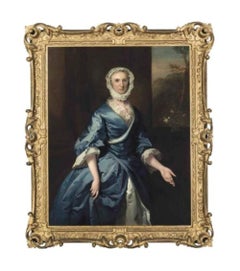Items Similar to Portrait of a Lady with a Shepherd's Crook
Want more images or videos?
Request additional images or videos from the seller
1 of 10
Joseph Wright of DerbyPortrait of a Lady with a Shepherd's Crook
$48,813.60
£35,715
€41,993.90
CA$68,153.46
A$74,333.16
CHF 39,081.34
MX$899,186.23
NOK 487,686.37
SEK 460,817.26
DKK 313,516.01
About the Item
Joseph Wright of Derby
Portrait of a Lady with a Shepherd's Crook
1734-1797
Oil on canvas, unsigned
Image size: 30 x 25 inches (76 x 63.5 cm)
Original carved gilt frame
Provenance
The Sitter
Family Descent
Christie's, Important Old Master Paintings, 27th January 2000, lot 154
Private Estate
This portrait depicts a lady sporting a fashionable blue and yellow dress as she cradles a blue bonnet and a houlette-style shepherd’s crook adorned with flowers. The shepherdess motif was a popular theme in 17th century portraiture, seeking to associate upper class women with the romanticised characterisation of rural women as humble, modest, and demure.
As is typical of the works of Joseph Wright of Derby, the use of light in this image is striking. Whilst not as marked as his exaggerated tenebrism in the candlelit scenes, Wright evidently has a keen eye for the way that light plays on surfaces such as skin and fabric. The light and shadow of the lady’s face and the slight tilt of her head promote the idea of movement; the shadow of the crook on her bonnet is incredibly accurate; and the shine of the fabric of her dress establishes a true sense of velvety texture. A high level of attention to detail is demonstrated in the rendering of the lace cuffs and sheer sleeves. This portrait also demonstrates Wright’s competency as a portraitist, as he realistically renders the facial features of the lady including her cleft chin, pursed lips, and her snub nose.
It is likely that this image was painted in the 1760s, shortly after Wright had departed the studio of Thomas Hudson. Hudson’s influence on this portrait is undeniable, and Wright’s use of light demonstrates an early mastery that would develop into the tenebrism he is renowned for.
Joseph Wright of Derby
Joseph Wright was born in 1734 in Derby, one of the British centres of the Industrial Revolution - a fact that undoubtedly shaped his subject matters in his career. Wright travelled to London to begin his painting career and studied under acclaimed portraitist Thomas Hudson. He painted portraits in Derby for a while whilst also working as an assistant to Hudson, and began to develop his flair for tenebrism (exaggerated chiaroscuro) which he would later become exceptionally well known for.
After a stint of painting portraits for prominent citizens in Liverpool in the 1770s, Wright set off to Italy with his wife, John Downman and Richard Hurleston. He visited Livorno and Naples and produced a number of paintings during this time. Upon returning to England, Wright tried to establish himself as a portraitist in Bath, but returned to Derby in 1777 due to a lack of patronage. Here, he began to paint portraits of the local gentry to furnish their estate houses.
Back in Derby, Wright befriended leading doctor Erasmus Darwin, who acquainted him with the Lunar Society of Birmingham and, by extension, the Midlands scene of the Enlightenment movement. Some of Wright’s most acclaimed paintings depict scenes from meetings of the Lunar Society of Birmingham, and many of his portraits depict the society’s members. As well as these scientific subjects, Wright often portrayed scenes from industrial life in the Midlands, including portraits of prominent industrialists such as Josiah Wedgwood and Richard Arkwright. His focus on his local area earned him the moniker ‘Joseph Wright of Derby’, and he is credited as being the first major painter with a career outside of London.
- Creator:Joseph Wright of Derby (1734 - 1797)
- Dimensions:Height: 30 in (76.2 cm)Width: 25 in (63.5 cm)
- Medium:
- Period:
- Condition:
- Gallery Location:London, GB
- Reference Number:1stDibs: LU52416777442
About the Seller
5.0
Vetted Professional Seller
Every seller passes strict standards for authenticity and reliability
Established in 2007
1stDibs seller since 2014
84 sales on 1stDibs
Typical response time: 2 hours
- ShippingRetrieving quote...Shipping from: London, United Kingdom
- Return Policy
Authenticity Guarantee
In the unlikely event there’s an issue with an item’s authenticity, contact us within 1 year for a full refund. DetailsMoney-Back Guarantee
If your item is not as described, is damaged in transit, or does not arrive, contact us within 7 days for a full refund. Details24-Hour Cancellation
You have a 24-hour grace period in which to reconsider your purchase, with no questions asked.Vetted Professional Sellers
Our world-class sellers must adhere to strict standards for service and quality, maintaining the integrity of our listings.Price-Match Guarantee
If you find that a seller listed the same item for a lower price elsewhere, we’ll match it.Trusted Global Delivery
Our best-in-class carrier network provides specialized shipping options worldwide, including custom delivery.More From This Seller
View AllPortrait of a Lady, Oil on canvas, 18th English Century Painting
By George Romney
Located in London, GB
Oil on canvas, unsigned
Image size: 22 x 20 inches (22.75 x 51 cm)
Pierced gilt frame
This half-length portrait shows the sitter with her head and eyes looking over her shoulder, to the right. She is dressed in a delicate blue dress and blue shawl with her hair tied up away from her face. The composition of the painting is simple but effective; the woman stands out and is the undeniable focus of the viewer's attention.
George Romney's artistic style is characterised by its focus on the beauty and elegance of human forms. Here, one can appreciate his ability to capture the delicacy of facial features and the soft textures of clothing. In addition, Romney has used a soft and diffuse brushstroke technique that creates a light and soft effect in the work. The dark and diffused background highlights the young woman's figure even more, creating an effect of depth and realism.
It is possible that this sitter is Miss Anne Dutton.
George Romney
Romney was a fashionable portrait painter of late 18th-century English society. In his portraits Romney avoided delving into the character or sensibilities of the sitter. His great success with his society patrons depended largely on just this ability for dispassionate flattery. Line rather than colour dominates; the flowing rhythms and easy poses of Roman classical sculpture underlie the smooth patterns of his compositions.
From 1755 to 1757 Romney was the pupil of Christopher Steele, an itinerant portrait and genre painter. Romney’s career began when he toured the northern English counties painting portraits for a few guineas each. In 1762 he went to London. His history painting The Death of General Wolfe won him an award from the Society of Arts; nonetheless he turned almost immediately to portrait painting. In 1764 he paid his first visit to Paris, where he was befriended by Joseph Vernet. Romney especially admired the work of Nicolas Le Sueur, whose use of the antique strongly appealed to him. In 1773 he went to Italy for two years, where he studied Raphael’s Stanze frescoes in Rome, Titian’s paintings...
Category
18th Century Portrait Paintings
Materials
Canvas, Oil
Portrait of a Girl, 18th Century Oil Old Master
By George Knapton
Located in London, GB
George Knapton
1698-1778
Portrait of a Girl
Oil on canvas
Image size: 20 x 18 inches
Original giltwood frame
This beautiful half length portrait of a young woman, turned to left, gazing at the spectator, wearing a pink, white lace-embroidered, dress, in her hair a pink bonnet trimmed with lace to match her dress.
The depiction of a young girl epitomises child portraiture of the late eighteenth century, in which painters such as William Beechey, Joshua Reynolds, Thomas Gainsborough had begun to discover and express the true character of children, in contrast to the stiff, miniature-adults of previous generations.
The Artist
Knapton was born in Lymington, one of four sons of James Knapton. He was apprenticed to Jonathan Richardson from 1715 to 1722, and in 1720 was a founding subscriber to the academy of St. Martin's Lane established by Louis Chéron...
Category
18th Century Old Masters Portrait Paintings
Materials
Canvas, Oil
Portrait of Lady Mansfield of Ringwood
By Thomas Hudson
Located in London, GB
Portrait of Lady Mansfield of Ringwood
Oil on Canvas, unsigned
Image size: 25 x 30 inches (63 x 76 cm)
Original carved & gilded frame
Provenance
Descended through the Family Estate
...
Category
18th Century English School Paintings
Materials
Canvas, Oil
Portrait of a Lady, Old Masters 18th Century Oil
By Thomas Hudson
Located in London, GB
Thomas Hudson
1701 – 1779
Portrait of a Lady
Oil on canvas
Image size: 30 x 25 inches
Original carved giltwood frame
Hudson had many assistants, and employed the specialist drapery ...
Category
18th Century Old Masters Portrait Paintings
Materials
Canvas, Oil
Portrait of Lady Mansfield of Ringwood
By Thomas Hudson
Located in London, GB
Portrait of Lady Mansfield of Ringwood
Oil on Canvas, unsigned
Image size: 25 x 30 inches (63 x 76 cm)
Original carved & gilded frame
Provenance
Descended through the Family Estate
Born in Poland in 1760 to the 2nd Earl of Mansfield and his wife, Elizabeth Mary Murray would later come under the care of her uncle, William Murray (1st Earl of Mansfield) at Kenwood House in Hampstead. David Murray (2nd Earl of Mansfield) was set to inherit the title and full wealth of his uncle, including Kenwood House. Lady Mansfield’s second cousin would soon join her at Kenwood, where they would be raised together and featured in multiple portraits of the time. Her younger sister, Henrietta, is seen in a separate portrait done by Thomas Hudson as well. At the age of 25 she married George Finch-Hatton, an English aristocrat and politician who sat in the House of Commons from 1772-1784.
Gazing out at the viewer, Lady Mansfield wears a decorated dress, with an abundance of pearls and lace, and a transparent gold lined veil surrounding her right shoulder. The excess of luxurious fabric matches another Hudson portrait of another Lady Mansfield, with the lace detailing and complementary bodice. The depiction of this Lady Mansfield epitomizes the style of portraiture in the 18th century, such as the styles Hudson’s pupils Joshua Reynolds, Joseph Wright, and Peter Toms. From Hudson’s travels to the Low Countries and Italy, he no doubt brought back artistic inspiration from the international pieces he encountered.
Thomas Hudson
Hudson was a celebrated 18th century portrait painter. Born in Devon in 1701 he studied under the artist Jonathan Richardson and married his daughter, against Richardson’s wishes.
He had many artistic friends including William Hogarth and Francis Hayman and travelled with them in Europe in 1748. He also visited Italy with the sculptor Louis-François Roubiliac in 1752. Hudson’s style of portraiture proved so successful that for a decade from 1745 to 1755 he was London’s most popular portrait painter and made a fortune painting the cream of London society and members of the Royal Family.
He was also a talented teacher, perhaps too good, as subsequently a number of his former assistants overtook him in popularity including the artist Joshua Reynolds.
Hudson retired in the late 1750’s and died in Twickenham in 1779. His most notable works include portraits of King George II and George Friedrich Handel and his “Portrait of a Nobleman in Van Dyck dress.” Many of Hudson’s works may be seen in art galleries. These include the National Portrait Gallery, the National Maritime Museum, the Tate Gallery, the Foundling Museum and the Bristol City Museum and Art Gallery. His works are also in Museums across the world...
Category
18th Century English School Paintings
Materials
Canvas, Oil
Portrait of Ann Austen, nee Grey
By Bartholomew Dandridge
Located in London, GB
Signed 'BDandridge/ pinxit' lower left
Provenance
By descent through the sitter's family to
The Collection of R. W. Vivian-Neal of Poundisford Park, Somerset, from whom acquired by
With Lane Fine Art, UK, where purchased by the present owners in 1996
Literature
'Poundisford Park, Somerset' in Country Life, 22 December 1934, ill.
A.W. and C.M. Vivian-Neal, Poundisford Park, Somerset: A catalogue of pictures and furniture, Taunton 1939, cat. nos. 11 and 13
This is a portrait of Ann Austen, nee Grey, three-quarter-length seated in a landscape with her dog. Painted in a superb white satin dress, she holds horn spectacles and a spectacle case...
Category
Mid-18th Century English School Portrait Paintings
Materials
Oil
You May Also Like
Portrait Of Lady as a Shepherdess 18th Century CHARLES JERVAS
By Charles Jervas
Located in Blackwater, GB
Portrait Of a Lady posing as a Shepherdess 18th Century
circle of CHARLES JERVAS (1675-1739)
Large 18th Century portrait of Lady oil on canvas, by Charles Jervas. Portrayed in the ...
Category
18th Century Portrait Paintings
Materials
Canvas, Oil
$9,293 Sale Price
20% Off
18th Century large scale portrait oil painting of a lady with a lamb
By Arthur Pond
Located in Nr Broadway, Worcestershire
Attributed to Arthur Pond
British, (1701-1758)
Portrait of a Lady
Oil on canvas
Image size: 50.75 inches x 41.5 inches
Size including frame: 58.5 inches x...
Category
18th Century Portrait Paintings
Materials
Canvas, Oil
Portrait of a Lady with a Blue Bow - British 18thC art Old Master oil painting
Located in Hagley, England
This superb British 18th century Old Master portrait oil painting is attributed to Matthew William Peters. Painted circa 1780 it is a fine half length portrait of a woman gazing to her left. She has a lovely blue bow and sash on her dress. The sympathetic detail in her face is sublime. A really wonderful 18th century Old Master portrait. Matthew William Peters was known for his late 18th century portraits which had both the influence of Sir Joshua Reynolds and Thomas Gainsborough.
Provenance. Lincolnshire estate.
Condition. Oil on canvas 30 inches by 25 inches unframed and in good condition. Has has restoration.
Frame. Housed in an ornate gilt carved swept period frame, 40 inches by 35 inches framed and in good condition.
Matthew William Peters (1742-1814) was an English portrait and genre painter who later became an Anglican clergyman and chaplain to George IV. He became known as "William" when he started signing his works as "W. Peters". Peters was born in Freshwater, Isle of Wight, the son of Matthew Peters (born at Belfast, 1711), a civil engineer and member of the Royal Dublin Society; by Elizabeth, the eldest daughter of George Younge of Dublin. The family moved from England to Dublin when Peters was young. Peters received his artistic training from Robert West in Dublin; in 1756 and 1758 he received prizes from the first School of Design in Dublin. In 1759, he was sent by the Dublin Society to London to become a student of Thomas Hudson and won a premium from the Society of Arts. The group also paid for him to travel to Italy to study art from 1761 to 1765. On 23 September 1762 he was elected to the Accademia del Disegno in Florence. Peters returned to England in 1765 and exhibited works at the Society of Artists from 1766 to 1769. Beginning in 1769, Peters exhibited works at the Royal Academy. In 1771 he was elected an associate and in 1777 an academician. He returned to Italy in 1771 and stayed until 1775. He also probably traveled to Paris in 1783–84, where he met Léopold Boilly, Antoine Vestier, and was influenced by the work of Jean-Baptiste Greuze. On 27 February 1769, Peters became a freemason, and he was made the grand portrait painter of the Freemasons and the first provincial grand master of Lincolnshire in 1792. In 1785, he exhibited portraits of the Duke of Manchester and Lord Petre as Grand Master at the Royal Academy exhibition. According to Robin Simon's article in the Oxford Dictionary of National Biography, no British contemporary had such an Italian manner of painting as Peters, reflecting the old masters he copied. Many of Peters' works were erotic and although these works did not damage his career, according to Simon, Peters later regretted these when he became an ordained clergyman in 1781. He served as the Royal Academy's chaplain from 1784 to 1788, at which time he resigned to become chaplain to the Prince of Wales. In 1784, Peters was awarded the living of Scalford, Leicestershire by Charles Manners, 4th Duke of Rutland. In 1788, the Dowager Duchess gave him the living at Knipton, at which time he also obtained that at Woolsthorpe. These livings were near to Belvoir Castle...
Category
18th Century Old Masters Portrait Paintings
Materials
Oil
$6,817 Sale Price
20% Off
Joseph Highmore Portrait of a lady, 18th century
By Joseph Highmore
Located in York, GB
Portrait of a lady, traditionally identified as Grace Loftus,of Beverley hall yorkshire.Three-quarter-length, before a window.
Dressed in blue and wearing a white bonnet. The paintin...
Category
1740s Old Masters Portrait Paintings
Materials
Oil
3rd Countess of Dysart, Grace Wilbraham
By Sir Godfrey Kneller
Located in Douglas, Isle of Man
Sir Godfrey Kneller 1646-1723, was a German born British portrait painter. He was born in Leiden and studied under Bol and Rembrandt, before travelling to Rome, Venice, Hamburg and ...
Category
Late 18th Century Portrait Paintings
Materials
Canvas, Oil
Portrait Of Miss Jones of Fonman Castle, Wales, circa 1730 by ENOCH SEEMAN
By Enoch Seeman
Located in Blackwater, GB
Portrait Of Miss Jones of Fonman Castle, Wales, circa 1730
by ENOCH SEEMAN (1689-1744)
Large 18th century three quarter length portrait of Miss Jones of Fonmon Castle, Wales, oil on canvas by Enoch Seeman. Excellent quality and condition portrait of a young Miss Jones wearing a gold satin dress...
Category
18th Century Portrait Paintings
Materials
Canvas, Oil
$10,715 Sale Price
20% Off
